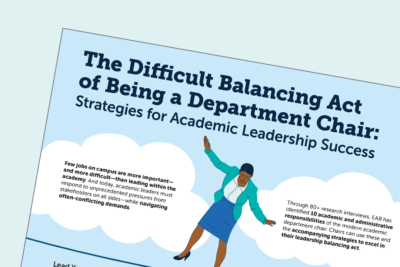Tips for recruiting university staff through candidate-centered, inclusive hiring
Colleges and universities often think of faculty and students first when the topic of diversity arises on campus. However, non-tenure, non-instructional staff make up more than 60 percent of a college’s paid employees, as shown in the table below. In fall 2020, two thirds of institutional staff were white while Black/African Americans and Hispanics/Latinos were most represented amongst campus’s lowest paying jobs.
Full-time staff by race/ethnicity and occupational category, fall 2020
National Center for Education Statistics
*Excludes instruction and research occupation categories

Much has already been said about the business case for diversity, but simply setting goals or metrics for minority hiring is transactional and impersonal. Candidates know the difference between a workplace that is trying to meet a quota versus one that has embraced diversity, equity, inclusion, and justice as part of its culture. To truly attract a diverse set of applicants, your institution must sell itself as an exemplary place to work both professionally and personally.
To begin recruiting a diverse pool of candidates, ensure all public-facing information indicates your institution’s desire to be an inclusive and equitable workplace. Start by reviewing job postings and web pages to make sure hiring information is up to date, policies are transparent, and the content demonstrates your campus’s efforts towards providing a welcoming, safe, and supportive workplace for all.
Review and refresh job postings to increase inclusive language and elevate diversity statements
1. Use inclusive language
Review and assure both internal and external job postings do not have gendered language or dropdown menus that would exclude anyone’s gender, racial, or ethnic identity. Using inclusive language in public-facing job advertisements helps applicants feel that your campus wants and welcomes diversity on campus. You can even employ technology to help create neutral job descriptions and reduce unconscious bias.
2. Broaden application requirements
Use broad application requirements in the position’s description to encourage a diverse set of applicants. For example, minimum education requirements and narrowly-scoped descriptions often dissuade potential candidates from applying because they feel they do not meet enough of the qualifications or required skills. If degree requirements can be reduced or skills can be reviewed through competency based hiring techniques, you can increase the size and depth of your candidate pool.
3. Include your institution’s diversity and equal opportunity statements
Include your institution’s diversity and equal opportunity statements and embed links to information about diversity efforts and disability accommodations. Easy-to-find information about diversity and inclusion initiatives shows your campus’s commitment to working with racially, neurologically, physically, and gender varied employees.
-
4 elements of an inclusive job ad
Identify where the greatest opportunities are to demonstrate a true commitment to faculty diversity and inclusion.
View Resources -
Close advancement's diversity gap by recruiting transferable-skills candidates
Read EAB’s guide to competency-based hiring for colleges and universities.
View Resources
View your employment and career site as your best marketing and branding tool
While institutions often think about how their website appeals to prospective students, little time is spent on “selling” or marketing to prospective employees. Imagining your HR or career site as a window into life as an employee can help candidates envision themselves living and working at your university.
1. Show that your institution does not treat diversity as an afterthought
Include information about on- and off-campus resources for various racial, ethnic, and religious groups. For example, include locations of nearby houses of worship and grocery stores catering to special dietary needs and diverse food options.
2. Provide as much information about staff benefits as possible
Review your policies around areas like parental leave, floating holidays, and health insurance coverage to ensure equitability. Ask yourself the following questions as you review your institution’s policies:
- Do parents of all genders receive the same amount of leave, and does the policy explicitly assure leave for adoption and surrogacy?
- Can individuals take time off for religious holidays without being penalized?
- Does your institution offer a health plan that allows people to find care reflective of their unique needs? For example, do health plans provide information about physician diversity? Are employees with preexisting conditions facing disproportionate costs?
- Do you have a way to assist employees who can’t meet insurance deductibles?
If you are at a public institution with little control over some of these benefit decisions, how can you work to advocate for more equitable benefits at a state level? What benefits, if any, are in your control that can be improved?
3. Demonstrate the efforts your institution has made and continues to make towards improving staff diversity
- Make mention of your institution’s frequent efforts to collect feedback by publicizing results from recent surveys. Indicate your intention to gather data and feedback from staff throughout the duration of their employment.
- Include links and information about employee resource groups, mentorship programs, and other opportunities for staff to become involved and welcomed on campus.
- Include testimonials, photos, and videos from staff across campus so applicants can see and hear from others that look and sound like them.
-
Advocate for staff with disabilities
For DEIJ missions and goals to be truly diverse, equitable, and inclusive, institutions of higher education must include disabilities in the conversation and ensure these staff members are supported.
-
Performance management resources
Review out-of-industry-inspired best practices to get the most from your performance management process.
Is your website accessible to candidates with disabilities?’
Find tips for improving website and interview accessibility through Employer Assistance and Resource Network on Disability Inclusion, The Job Accommodation Network, The National Association of the Deaf, and the American Foundation for the Blind. You can also contact the U.S. Equal Employment Opportunity Commission and the Office of Disability Employment Policy to help guide you towards the right resources.
More Resources

The difficult balancing act of being a department chair

Succession Planning Toolkit
